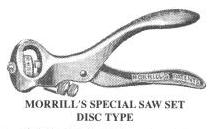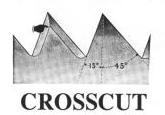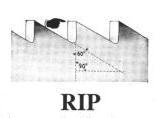

For any saw to cut properly requires just the
right amount of set. Too much and the saw requires too much effort
to use, too little and it binds in the cut. In this article we'll
investigate what set is, figure out how much is needed, and discuss
how to properly apply it.
Saw set is the slightly increased thickness of the blade at the
cutting edge. This is necessary because if the blade were a constant
thickness throughout, the saw would soon bind in the wood being
cut due to the friction bearing against the sides of the saw.
To overcome this problem, the blade is  made slightly wider
at the cutting edge by bending every other tooth outward away
from the center of the blade. This bending is accomplish with
a saw set, a specialized tool made just for this purpose. The
increased thickness of the blade at the cutting edge causes the
saw to cut a wider kerf than the saw is thick, allowing the saw
to cut quickly and efficiently through the work.
made slightly wider
at the cutting edge by bending every other tooth outward away
from the center of the blade. This bending is accomplish with
a saw set, a specialized tool made just for this purpose. The
increased thickness of the blade at the cutting edge causes the
saw to cut a wider kerf than the saw is thick, allowing the saw
to cut quickly and efficiently through the work.
The topic of how much set is required in a saw is one that has
many answers. It depends on factors such as the type of blade,
the thickness of the blade, and the type of material being cut.
First of all, saw blades are generally found of two types, taper
ground and constant thickness. By far the most desirable is a
taper ground blade. A blade that is taper ground is thicker along
its edge than it is at the back. This is a great help in applying
set as the blade already has a certain amount of clearance built
in. A blade that is taper ground requires less set than one that
is a constant thickness. This causes the overall thickness of
the edge to be thinner and results in a thinner kerf. A thinner
kerf requires less effort to cut than a thicker one. It is for
this reason that saws with taper ground blades are so desirable.
The thickness of the saw blade is also important. Most high quality
taper ground blades are about .035 inches thick at the cutting
edge. They vary from manufacturer to manufacturer. Blades that
are about this thickness seem to strike a good balance in that
they are thin enough to produce a narrow kerf, but thick enough
not to kink while in use. Blades that are a constant thickness
generally fall into two categories, saws that are very old, and
saws that are of recent manufacture. Saws tat are very old, that
is that date from the early 19th century and before, are usually
the same thickness throughout due to the limitations of grinding
equipment at that time. Saws produced in the mid 19th century
to the late 1960s are usually taper ground. Some lesser quality
saws of this vintage can be found with constant thickness blades.
Saw blades of very recent manufacture are also usually the same
thickness throughout, and should be avoided.
The amount of set required is different for softwoods (or wood
that is wet) and dry hardwoods. Dry hardwoods require much less
set than do softwoods or woods that have not been dried. For softwoods,
this is due to the resinous pockets that are encountered in the
cut as well as the gummy nature of the saw dust created during
the cut. For woods that are wet, this is due to the gummy nature
of the dust as well as the tendency of the wood being cut to warp
and twist as it is cut.
The actual amount of set applied to the blade is measured with
a micrometer A good method to use is to measure the thickness
of the blade just above the teeth to get an idea of how thick
the blade is without any set. Unless a saw has just had new teeth
cut, it will have at least some set. Let's say we measure the
saw in question and the blade is .035 inches thick. A good rule
of thumb is to increase the thickness  of
the blade by 20% for dry hardwoods, and 25-30% for softwoods.
So, our .035 blade would need to be increased to .042 inches for
use in hardwoods, or up to .046 inches for softwoods and wood
that is wet. This is just a guideline, but it is a good place
to start until experience with your particular set is gained.
After setting a few saws and receiving feedback from the work,
you'll define a very narrow range on your set which produces good
results time after time without going through the hassle of measuring
your blade and doing calculations. It should be noted that blades
with constant thickness will often require even more set. Sometimes
so much set is required that it takes forever to make a cut due
to the extreme amount of material that must be removed. It is
for this reason that constant thickness saws are best avoided.
Fortunately, 90% of the saws that are encountered are taper ground.
of
the blade by 20% for dry hardwoods, and 25-30% for softwoods.
So, our .035 blade would need to be increased to .042 inches for
use in hardwoods, or up to .046 inches for softwoods and wood
that is wet. This is just a guideline, but it is a good place
to start until experience with your particular set is gained.
After setting a few saws and receiving feedback from the work,
you'll define a very narrow range on your set which produces good
results time after time without going through the hassle of measuring
your blade and doing calculations. It should be noted that blades
with constant thickness will often require even more set. Sometimes
so much set is required that it takes forever to make a cut due
to the extreme amount of material that must be removed. It is
for this reason that constant thickness saws are best avoided.
Fortunately, 90% of the saws that are encountered are taper ground.
So, we've determined how much set is required, but now how to
apply it? There are many, many different types of saw sets that
one could use. The simplest type is a saw wrest which is nothing
more than a piece of steel with slots cut into the edge. The slots
are of various thickness for different thickness blades. Saw wrests
are difficult for the novice to use, and tedious for the experienced.
It is for this reason that there were so many different types
of mechanical saw sets developed. There are basically two major
types that are likely to be encountered. Both have two handles,
one of which moves and pushes a plunger forward to set the tooth.
The difference is in the construction of the anvil. The anvil
is the part of the saw set that the tooth is pushed up against.
The farther the anvil is away from the tooth, the more set the
saw tooth receives. One major type of saw set has a rotating disc
for an anvil. The disc is ground so that the  edge
is gradually relieved more and more. In addition, numbers are
stamped around the edge of the disc which are supposed to correspond
to the pitch of the teeth being set. if this type of set is to
be used, it is my experience that it is best to avoid relying
on these numbers and instead set up a baseline by trial and error.
The second major type of set has an anvil which consists of a
beveled piece of steel which can be slid up and down a track.
This type of set usually just has arbitrary graduations instead
of actual numbers. This type of set is by far my favorite. The
Stanley 42X saw set is of this type and is a very well designed,
easy to use tool. Even better, they can be found for $20-40 on
the old tool market, often in their original box with instructions.
edge
is gradually relieved more and more. In addition, numbers are
stamped around the edge of the disc which are supposed to correspond
to the pitch of the teeth being set. if this type of set is to
be used, it is my experience that it is best to avoid relying
on these numbers and instead set up a baseline by trial and error.
The second major type of set has an anvil which consists of a
beveled piece of steel which can be slid up and down a track.
This type of set usually just has arbitrary graduations instead
of actual numbers. This type of set is by far my favorite. The
Stanley 42X saw set is of this type and is a very well designed,
easy to use tool. Even better, they can be found for $20-40 on
the old tool market, often in their original box with instructions.
The conventional wisdom is to set a saw's teeth
before it is sharpened. I disagree with this approach for several
reasons. If a saw is set before it is sharpened, then part of
the set is removed when the teeth are filed. It is very difficult
to try to figure out how much the set is decreased in filing as
it is dependent on many factors such as how sharp the file is,
how hard you bear on the tooth with the file, and how uniform
the saw teeth are filed. I prefer to set the saw after it has
been sharpened. The saw set, of course, being made of cast iron
will dull the teeth unless steps are taken to prevent it. I tape
small pieces of veneer on the part of the set that the saw teeth
bear on with double stick tape. After setting a few saws, the
veneer will start to wear through and is easily replaced. By setting
the saws teeth after it has been filed, a very uniform set can
be achieved which not only makes the saw cut well, but also makes
a very nice finish on the piece being cut. It only takes one or
two teeth to be over-set to make the edge of a cut piece of wood
ragged and rough.
Actually, setting a saw is a fairly quick and easy task. It doesn't
matter where you start, at the heel or the toe of the saw. I like
to start at the heel of the saw because these teeth usually aren't
used in cutting which make them ideal candidates to use for calibrating
your set. It is important where the plunger hits the tooth to
provide the best set. In crosscut  teeth, line the
plunger up so it contacts the tooth exactly where the two fleam
angles come together. Hitting the tooth here gives you the best
leverage and provides a very uniform set. For rip teeth, let the
plunger make contact with the tooth just below the cutting point.
It is very important
teeth, line the
plunger up so it contacts the tooth exactly where the two fleam
angles come together. Hitting the tooth here gives you the best
leverage and provides a very uniform set. For rip teeth, let the
plunger make contact with the tooth just below the cutting point.
It is very important  that you not push on the center
of the rip tooth as you have very little leverage there and consequently
won't move the tooth over very much. What I mean by leverage is
that the other side of the tooth is sloped back at a 60 degree
angle. The closer you get to the slope, the harder it is to move
the tooth out away from the blade. Staying on the other side of
the tooth increases the length of the lever and makes it easier
to push the tooth. It sounds confusing, but after setting a few
teeth, you'll quickly understand what I'm talking about. Adjust
your set to a minimal setting. Start at the first tooth under
the handle and line up the set plunger on the tooth. Firmly and
smoothly grip the handle to set the tooth. It is very important
to use the same amount of pressure each and every time you set
a tooth. To do otherwise results in teeth that have different
amounts of set which will make the saw difficult to use. Skip
a tooth and set the next tooth, and so on. After about an inch
has been set, flip the saw around and set the teeth you skipped
from the other side. When you're done, you'll have a small amount
of blade to place your calipers on and take a measurement. Hopefully,
you'll be short of the desired thickness. Increase the amount
of set by moving the anvil on your saw set. Repeat the procedure
on the same teeth and measure again. Continue until you've reached
the amount of set calculated. Once your saw set is calibrated,
set one entire side of the saw, turn the saw around, and set the
teeth on the other side that you skipped. When you are done, sight
along the teeth. They should be evenly bent outward, the same
on each side.
that you not push on the center
of the rip tooth as you have very little leverage there and consequently
won't move the tooth over very much. What I mean by leverage is
that the other side of the tooth is sloped back at a 60 degree
angle. The closer you get to the slope, the harder it is to move
the tooth out away from the blade. Staying on the other side of
the tooth increases the length of the lever and makes it easier
to push the tooth. It sounds confusing, but after setting a few
teeth, you'll quickly understand what I'm talking about. Adjust
your set to a minimal setting. Start at the first tooth under
the handle and line up the set plunger on the tooth. Firmly and
smoothly grip the handle to set the tooth. It is very important
to use the same amount of pressure each and every time you set
a tooth. To do otherwise results in teeth that have different
amounts of set which will make the saw difficult to use. Skip
a tooth and set the next tooth, and so on. After about an inch
has been set, flip the saw around and set the teeth you skipped
from the other side. When you're done, you'll have a small amount
of blade to place your calipers on and take a measurement. Hopefully,
you'll be short of the desired thickness. Increase the amount
of set by moving the anvil on your saw set. Repeat the procedure
on the same teeth and measure again. Continue until you've reached
the amount of set calculated. Once your saw set is calibrated,
set one entire side of the saw, turn the saw around, and set the
teeth on the other side that you skipped. When you are done, sight
along the teeth. They should be evenly bent outward, the same
on each side.
The ultimate test of any set job is how well the saw cuts. Take
some scrap and start a cut. The saw should glide through the wood
without jumping around in its kerf. It should not be hard to push,
nor should it be "roomy" in the kerf. If either of these
conditions exist, increase or decrease the set accordingly. If
the saw tracks away from the line, the side of the saw that is
furthest from the line has too much set. A simple remedy is to
lightly stone the edge of the offending side with a medium India
slipstone. Take one swipe with the stone, and try another cut.
Usually only one or two passes with the stone will correct the
problem. Don't remove too much, however, or you'll have the same
problem on the other side until not enough set is left to make
the cut.
Once you've determined by trial and error that you have just enough
set on that particular saw, make a note of where your saw set
is adjusted for future reference. You'll find that you'll move
your set very little for all the different saws in your shop.
A properly set saw is essential for trouble free, enjoyable cutting.
Once you understand what set is, why it's important and how to
apply it, you'll be a long way toward that enjoyment.
Art work from:
Disston Saw Tool and File Manual, 1936.
Biddle Co. Catalog 1910
© 1997 Peter Taran. All rights reserved.